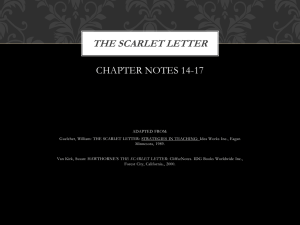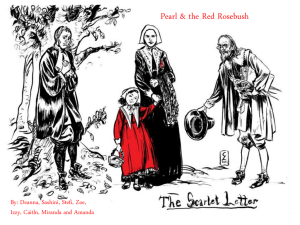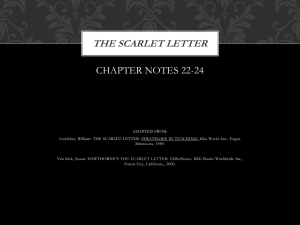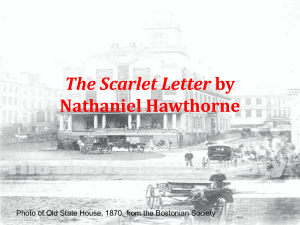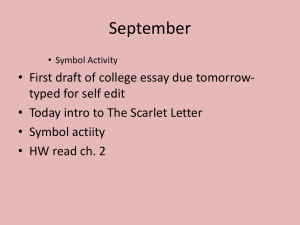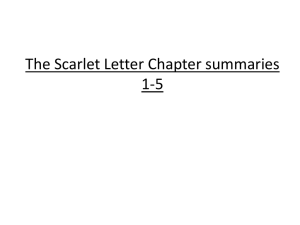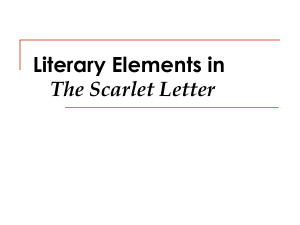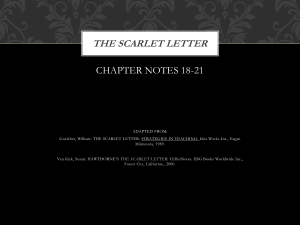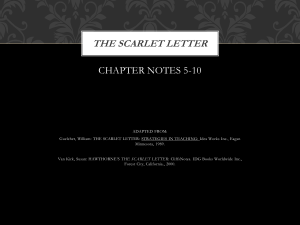Symbolism TSL - WordPress.com
advertisement
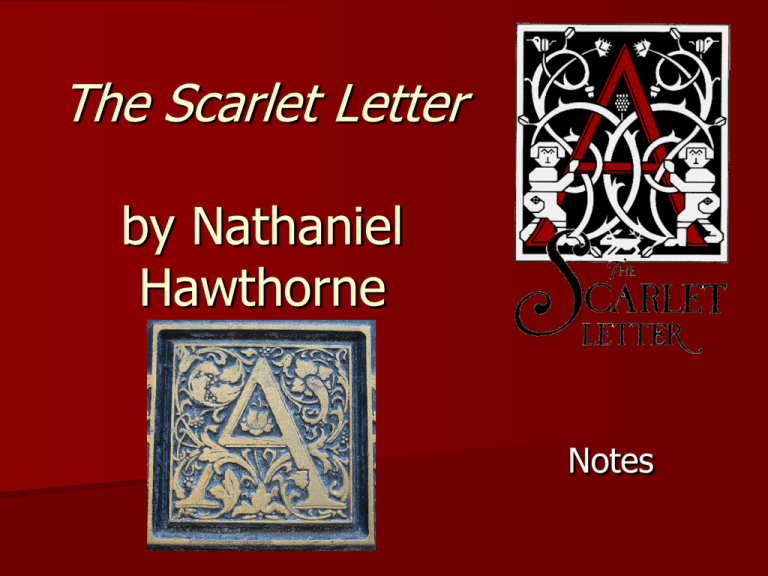
The Scarlet Letter by Nathaniel Hawthorne Notes Major characters in The Scarlet Letter Arthur Dimmesdale Hester Prynne daughter Pearl Roger Chillingworth Symbolism The Scarlet Letter is filled with symbolism. Symbolism is when one thing is used to represent something else. Darkness vs. Light Sunshine seldom shines on Hester, but often on Pearl. Sunshine represents goodness while the darkness represents evil and hidden sins. The forest is a dark and forbiding place that the Puritans felt was full of evil. This is the place where Hester and Arthur meet years after Pearl is born,and it is only there that they can feel free enough to express their long repressed feelings for one another, for it is here that the rules of society cannot penetrate The Sunlight Does Not Shine on Hester “Mother,” said little Pearl, “the sunshine does not love you. It runs away and hides itself, because it is afraid of something on your bosom. . . . It will not flee from me, for I wear nothing on my bosom yet!” “Nor ever will, my child, I hope,” said Hester. “And why not, mother?” asked Pearl, stopping short. . . . “Will it not come of its own accord, when I am a woman grown?” Dimmesdale Hides in the Light It is only in the dark of night that Arthur Dimmesdale can allow himself to come out and "reveal" his sin as he does in the dark of night on the scaffold where Hester’s sin was revealed in the light of day. The Letter “A” The "A" represents adultery in the beginning of the book. It is Hester's punishment for committing sin. She wears it with stoic endurance and embellishes it with gold threads until it becomes a thing of beauty. Later in the novel, the town has forgotten Hester's original sin. Now the "A" is thought to represent "able" or "angel" . When the meteor makes a phenomenal "A" in the night sky, the town is in awe of its wonder. They think it must be "Angel" . We may also associate it with “Alone” or “Alienation” The Rosebush by the Prison Door The prison is a place of despair and doom, but the rose growing by the door represents the beauty and forgiveness of nature. Weeds and Poisonous plants The Rose at Governor Bellingham’s house Meteor As Dimmesdale stands on the scaffold with Hester and Pearl in Chapter XII, a meteor traces out an “A” in the night sky. To Dimmesdale, the meteor implies that he should wear a mark of shame just as Hester does. The meteor is interpreted differently by the rest of the community, which thinks that it stands for “Angel” and marks Governor Winthrop’s entry into heaven. Names Pearl - Although Pearl is a complex character, her primary function within the novel is as a symbol. Pearl is a sort of living version of her mother’s scarlet letter. She is the physical consequence of sexual sin. Hester Prynne The protagonist of the novel who is an English woman and the wife of Roger Chillingworth. She is tried and condemned for her sin of adultery with Dimmesdale and charged to wear the scarlet letter, "A", an indication of adultery, on the bosom of her gown forever. Even though she has a daughter out of wedlock, she refuses to reveal who the father is. As a young woman, her youthful beauty, luxuriant hair, and excellent features are diminished by her self-effacing puritanical way of dressing. As an older lady, she returns to Boston where she is finally accepted for her kindness and service. Arthur Dimmesdale The young, handsome, and unmarried pastor of Hester's church. Apart from committing adultery with Hester, he is guilty of hiding his sin. His intense suffering and remorse, however, are reflected in his rundown physical appearance. He emerges as the tragic figure of the novel around whom revolves the plot's suspense and on whom the reader's attention is centered. Thus, he is also considered a protagonist, like Hester. Roger Chillingworth A scholarly physician who has sent his wife ahead of him to America. He fails to join her quickly, for he is captured by Indians from whom he gathers a knowledge of herbal medicine. He is an old, evil, vicious, ugly, and deformed man. His diabolical vengeance on Dimmesdale, while pretending to treat him, makes him the personification of evil. Pearl The beautiful daughter of Hester and Dimmesdale. She is the living symbol of the scarlet letter and has peculiar traits that make her sometimes appear as a demon. Her love for nature and freedom, her vivacious spirit, her alienation, her rebelliousness, her inquisitiveness, and her innocent but symbolic comments reveal her distinct personality. She is, however, a product of the difficult situation into which she is born. Pearl Pearls are formed in oysters when a grain of sand slips inside and irritates the oyster. The oyster covers the irritant and it becomes a thing of rare beauty. Just like a real pearl , Pearl in The Scarlet Letter is born of her mother's shame and suffering , but has become a precious, rare, and beautiful child. The Main Themes of The Scarlet Letter Sin and its effect on the individual Hawthorne explores this by tracing the consequences of different kinds of sin on 3 different characters: Hester, Dimmesdale, and Chillingworth. The consequence of sin is alienation, and as their sins differ, so do the kinds of alienation that result from them. Cont. Hester’s isolation is physical – the townspeople shun her. There is a magic circle of ignominy caused by her scarlet letter. However, the scarlet letter is the means to her redemption. Hawthorne believes that no reconciliation with God, society, or self can happen without confessing one’s sin and coming to terms with it. “Be true! Be true! Show freely to the world, if not your worst, yet some trait whereby the worst can be inferred.” Hester’s pregnancy makes her sin known and she works out her redemption slowly and painfully in public view. The A changes from Adultery to Able. Cont. Dimmesdale suffers agonizing guilt and self-loathing The admiration of his parishioners wounds him because of his sense of unworthiness and alienation from God. His redemption is possible only when he publicly confesses his sins on the scaffold (and not at night when no one was there to hear). Cont. Chillingworth’s sin lies in his single-minded pursuit of vengeance – in violating “in cold blood, the sanctity of the human heart.” His obsession transforms him into a fiend. His isolation is represented by the dread his dark and stooping posture inspire in the children of the town (remember Pearl sees him as a Devil). His secret sin, which finally destroys him, is unpardonable because he himself is unable to forgive. Another Theme Another theme is that Sin brings special knowledge or insights to the sinner (just like eating the forbidden apple gave insight to Adam and Eve) Hester sees the sins of others Dimmesdale in able to look into the hearts of his parishioners Chillingworth has insights into Dimmesdale’s soul Mistress Hibbins (the resident witch) intuitively sees into the minister’s soul Pearl, who isn’t a sinner but who is born as the result of sin, can figure out that Dimmesdale is his father without being told. The Structure of the Novel The novel is symmetrical. Very carefully planned out. The Three Main Scenes All take place on the scaffold They underscore the unity of the novel They bring together the four major characters and show their changing circumstances throughout the novel. Themes Themes are universal ideas that an author wants to express through his/her writings. A theme is not the “topic”, but rather an idea about the topic that an author wants to put forth. Themes can be expressed as a sentence: a universal statement that should apply beyond the story. Forgiveness and Revenge CHillingsworth seeks his revenge for Hester's adultery, but it poisons his soul and destroys any happiness he might have found. His only vindication comes when he leaves his inheritance to little Pearl. Guilt and Innocence Hester accepts her guilt and her punishment without complaint. Arthur Dimmesdale hides his guilt, and it destroys him from within. He cannot bear what he has done, but has not the courage to face his sins. Pearl is the innocent product of her parent's guilt and sin, but she is innocent and beautiful. She grows up to live a life of luxury. Truth and Lies Arthur Dimmesdale cannot face his sin. He does not have the courage to face his punishment. He secretly carves the “A” into his chest in a vain attempt to punish himself. The real punishment is that which his own guilt and lies do to his soul. They destroy him from within. Hester accepts her punishment. She does not hide from it, and she is , at the end, vindicated because no one remembers her sin. Roger Chillingsworth hides his true identity. In so doing, he becomes filled with bitterness, hatred, and evil. It is only when he leaves an inheritance to little Pearl that the reader feels any sympathy toward him. Be True Because both Chillingworth and Dimmesdale live a lie, they suffer more than Hester, whose sin is known. Hypocrisy The townspeople shun Hester and the children are forbidden to play with little Pearl. Yet they seek Hester's skills as a seamstress, and they secretly envy the beauty of the embellished "A" that adorns her clothing....adornment that they, as Puritans of plain and simple lifestyle are forbidden to wear. Arthur Dimmesdale enjoys the prestige of being a well-respected minister, a man of God. Yet, he is the father of Hester's child, the sinful adulterer the townspeople want Hester to name. Pride It is Hester’s pride that helps her survive . It is Arthur Dimmesdale’s pride that leads to his destruction. It is Roger Chillingworth’s pride that leads him to be a bitter, evil person obsessed with vindictiveness. Irony Irony of situation : When we expect one thing to happen, but the opposite happens instead. Verbal Irony: When someone says one thing, but actually means the opposite. Dramatic Irony: When the reader knows something that the characters in a story do not know. Dramatic Irony in The Scarlet Letter The reader knows that Arthur Dimmesdale is Pearl’s father. The townspeople do not know this. The reader knows that Roger Chillingworth is Hester’s husband. The townspeople do not know this. Situational Irony in The Scarlet Letter The symbol of Hester’s sin ( the “A”) that could have destroyed Hester has made her stronger and envied by those who shunned her. Irony (cont.) The "A" that Hester is forced to wear, and which she hates in the beginning, becomes a valued part of her identity. She even refuses to remove it when she no longer is required to wear it. She panics when the town considers allowing her to remove it. Irony (cont.) The sin that Arthur Dimmesdale hides because he is afraid it will destroy his reputation as the revered minister ends up destroying his very life. Irony (cont.) Pearl, who is shunned along with her mother, grows up to have all the luxuries that those who shunned her will never have. Cont. Dimmesdale A character so weak that only Hester’s love and his extreme suffering lend him reality. Some consider him the protagonist because he is the tempted one, the one who is persecuted, and the one whose confession climaxes the novel Cont. Chillingworth – Somewhat of a stock character (which may take away from his believability) He does change in the novel (though we never really see the scholar who was “thoughtful of others, craving little for himself” His change into the fiend that wants revenge is pDimmesdale of what causes Hester to feel guilt Cont. Pearl – The only character who suffers as a result of a sin she didn’t have anything to do with Symbolic in nature – is a living representation of Hester’s sin and is definitely pDimmesdale of her punishment as well as her salvation Is finally humanized in the final chapter Irony Situational Irony – the fact that Chillingworth, the wronged husband, whom might normally gain the sympathy of the reader, ends up being a fiend. He is a physician, whose mission should be to cure, and he affixes himself to Dimmesdale, who he eventually plans to make suffer for the rest of his days. It is also ironic that Dimmesdale, who is agonized by guilt Dramatic Irony- occurs mostCont. often when Hester and Dimmesdale meet in public and must communicate in ways that the onlookers will not understand (ex. When Dimmesdale asks Hester to reveal the father of her child) Verbal Irony – Example would be when Hawthorne accounts for the popularity of Hester’s needlework among the Puritans as follows: “Vanity, by putting on…the garments that had been wrought by sinful hands.” Symbolism Some symbols keep the same significance throughout – the scaffold, which represents public notice, and weeds and unsightly vegetation which stand for moral evil. Others, like the forest, which represents both nature and the threatening powers of the Black Man, are ambivalent. The central symbol, the Scarlet Letter, does change in meaning, as Hester works her way towards absolution. Chapter 1 Notes Chapter 1 - Summary This chapter sets the scene (17th c Boston) Drably dressed Puritans gathered in front of the prison In front of the prison is a growth of weeds, and beside it grows a wild rose bush. Chapter 1 – Analysis The rust, decay, and ugliness foreshadow the gloom of the novel. Two landmarks ---the prison & cemetery– point to themes of punishment & death. Although the rose is beautiful, it is a striking contrast to everything else. Chapter 2 Notes Chapter 2 - Summary Puritans are gathered in front of the prison to witness a public punishment. Most of the women appear self-righteous in discussing Hester Prynne’s sin. Proud & beautiful, Hester emerges from the prison wearing an elaborately embroidered scarlet letter A on her dress. The A stands for adultery. Chapter 2 - Summary Hester is carrying a three-month old infant in her arms. The crowd is unsympathetic as Hester walks toward the scaffold of the pillory. Chapter 2 - Summary While standing on the pillory, Hester dreams of her past life in England (with her father) and on the Continent (with her “misshapen scholar” husband). Stern faces watch Hester. Hester is painfully aware of her present position of shame and punishment. Chapter 2 – Analysis Pearl is the symbol of Hester’s sin. Roger Chillingworth (the misshapen scholar) is Hester’s legal husband. Hawthorne reveals his critical attitude toward Puritan society (probably due to his family background). Chapter 2 – Analysis The goodwives condemn Hester and suggest more violent torture. Hawthorne objected to this type of attitude in early American Puritanism. Hawthorne avoids over-generalizing Puritans by including one character who is somewhat sympathetic toward Hester. This chapter is heavy in historical narrative. Chapter 3 Notes Chapter 3 - Summary In this chapter, Hawthorne reveals that Hester was sent ahead from Europe by her husband. Hester has been in Boston for two years without any word from her husband. Because Hester was with child, she was not executed for the sin of adultery. Hester’s punishment is standing on the scaffold for three hours & wear the symbolic letter for the rest of her life. Chapter 3 - Summary Hester’s husband encountered problems in crossing the Atlantic Ocean. At some point, he was held captive. These problems delayed him from reaching Hester. Hester’s husband is upset that the baby’s father is not sharing in the public punishment. Chapter 3 - Summary Hester dreads talking to her husband. The Reverend Mr. John Wilson is Boston’s oldest and most famous minister. The young Reverend Mr. Arthur Dimmesdale’s voice tone reveals a kindness toward Hester. Hester refuses to name the father of her child. Pearl cries and screams. Chapter 3 – Analysis Reverend Dimmesdale is the father of Pearl. This fact makes his passionate appeal one of the richest passages of irony in the book (there is a strong undercurrent of personal meaning in Dimmesdale’s public remarks). Chapter 4 Notes Chapter 4 - Summary Back in the prison cell, Pearl convulses in pain. Hester’s husband poses as a physician by the name of Roger Chillingworth, and does not reveal that he is married to Hester. Although fearful he will harm the baby, Hester allows Chillingworth to give the baby medicine. Still in fear, Hester accepts some sedative. Chapter 4 - Summary The sedative calms Hester. Hester and her husband talk intimately and sympathetically---both accept a measure of blame for the current situation. Chillingworth does not want revenge against Hester; however, he wants to know who violated his marriage. Chapter 4 - Summary Since Hester is concealing the identity of her lover, Chillingworth requests that Hester also keep her husband’s identity secret. Chillingworth promises not to take the life or damage the reputation of her unknown lover (if Hester doesn’t give the name of her husband). Chapter 4 - Summary Chillingworth warns Hester if she fails to keep his identity secret, then he will hurt Pearl’s father. Chapter 4 – Analysis This is one of the more dramatic chapters of the book. Regarding the development of Chillingworth, we see both what he has been and what he is to become. Chillingworth is a lonely, gentle scholar who has been robbed of his wife; however, he has an element of selfdestruction in his grim determination to discover the man who has caused him offense. Chapter 4 – Analysis Hester never pretended to love her husband. Hester does deeply love Pearl’s father. It is Hester’s concern for Dimmesdale (more than her sense of obliagation to Chillingworth) that persuades her to swear to keep her husband’s secret. *This promise will make Hester and her lover suffer later in the book. Chapter 5 Notes Chapter 5 Summary After her imprisonment, Hester is free to leave Boston; however, she moves into a small thatched cottage on the outskirts of town. Hester supports herself as a seamstress. Her work is in demand for everything but wedding dresses. Hester remains a social outcast. She patiently takes abuse from the townspeople. Chapter 5 – Analysis The primary function of this chapter is to show Hester undergoing penance. Hester goes beyond the letter of the law– staying in Boston (atmosphere of torture) when she could leave. Hester dresses in the coarsest and most somber attire when her natural taste is for the rich and beautiful. Despite Hester’s apparent humility and her refusal to strike back, she resents and inwardly rebels against the viciousness of her Puritan persecutors. Chapter 6 Notes Chapter 6 – Notes At age three, Pearl is a physically beautiful, vigorous, and graceful little girl. Pearl has unusual depth of mind but an uncontrollable, fiery passion (neither threats or kindness of Hester can control this side of Pearl). Hester makes rich, elaborate dresses for Pearl. Chapter 6 – Notes Pearl’s mischief and disrespect for authority remind Hester of her own sin of the passions. Hester names her daughter “Pearl” because she came at a “great price.” Chapter 6 – Notes Hester and Pearl rely on one another because they are excluded from “respectable” society. Pearl does not try to make friends; rather, she throws rocks and screams at the other children. Pearl’s only companion in play is her imagination—but even in her games of makebelieve she never creates friends. Pearl does create make-believe enemies (Puritans) she plans to destroy. Chapter 6 – Notes The object that most captures Pearl’s attention is the scarlet letter on her mother’s dress. As an infant, Pearl grasped at the letter. As a child, Pearl threw wild flowers at the letter. Pearl denies having a Heavenly Father and demands that Hester explain where Pearl came from. Chapter 6 -- Analysis Hester’s interpretation of Pearl’s behavior as almost supernatural or fiendish takes place primarily in Hester’s mind. Hester deeply loves Pearl but cannot understand her and somewhat fears Pearl. Chapter 7 Notes Chapter 7 -- Summary Hearing that influential citizens are going to take Pearl away from her, Hester goes to Governor Bellingham’s mansion. Under the pretext of taking him gloves, Hester plans to plead for the right to keep her daughter. When she is taunted by a group of Puritan children, Pearl screams and threatens the children. Chapter 7 – Summary Leech is an archaic term for a physician. Hester attempts to quiet Pearl who is crying and screaming for one of the red roses from the garden. Chapter 7 -- Analysis The scarlet A is strengthen by two striking variations: the magnified A in the breastplate, and Pearl as a living version of the scarlet symbol. Chapter 8 Notes Chapter 8 -- Summary The Governor is shocked by Pearl’s vain and immodest costume. He doubts Hester’s fitness to raise Pearl in a Christian way. The Governor instructs Reverend Wilson to test Pearl’s knowledge of religious items. Although Hester has taught Pearl much more about religion than most three year olds, Pearl deliberately pretends ignorance. Chapter 8 -- Summary After a plea from Hester, Dimmesdale persuades the Governor and Wilson to let Pearl remain with her mother (as a blessing from God & as a reminder of sin). Leaving the mansion, Mistress Hibbins (the governor’s sister) invites Hester to a midnight meeting of witches in the forest. Hester declines. Chapter 8 Analysis For the first time in three years (since the scaffold) the four main characters are together. This chapter contains the first hints as to Dimmesdale being the father. Dimmesdale has been suffering with his concealed guilt. Chillingworth physically appears more ugly, dark, and misshapen. Chapter 9 Notes Chapter 9 Summary Some Puritans believe that it is as special act of Providence that Chillingworth has arrived and can take care of Dimmesdale. Dimmesdale and Chillingworth have separate apartments in the same house. Gradually, the townspeople become suspicious of Chillingworth; however, they have faith that Dimmesdale is strong enough to overcome his tormentor. Chapter 9 – Analysis For Dimmesdale, the relationship with Chillingworth is dangerous. There is a Satanic turn in Chillingworth’s character Chapter 10 Notes Chapter 10 -- Summary Chillingworth is obsessed with discovering the truth. Chillingworth asks Dimmesdale why a man should be willing to carry secret sins to the grave rather than confessing them during his lifetime. Dimmesdale replies that most men do confess but that some men do not because they would no longer be able to do God’s work on earth. Chapter 10 -- Summary Chillingworth finds Dimmesdale asleep in a chair. He pulls aside the minister’s vestment (ceremonial robe) and finds a letter A carved into the skin. Chillingworth experiences feelings of wonder, joy, and horror. Chapter 10 Analysis Chillingworth has become diabolical in his determination. As seen in chapter ten, this is the most vicious side of Chillingworth; however, Hawthorne reminds the reader that C had once been kindly, pure, and upright. C did not choose a path of evil. C is a victim of his need to seek the truth. D is a victim of his own weakness. Dimmesdale is consumed with painful inner suffering. He is wasting away from the struggle with his soul. Chapter 11 Notes Chapter 11 -- Summary Knowing the secret, Chillingworth begins his unrelenting torture of Dimmesdale. Dimmesdale begins to abhor Chillingworth Dimmesdale tolerates Chillingworth because he feels the dislike stems from an impurity in his own heart. Dimmesdale becomes more popular among the congregation. D’s suffering allows him to sympathize with the sin and suffering of others. Chapter 11 -- Summary The misplaced adoration (from the congregation) tortures Dimmesdale and he wants to confess. Incapable of the one act necessary for his salvation, Dimmesdale substitutes selfpunishment (often by beating himself with a bloody scourge) & walks the house at night. Chapter 11 -- Analysis Hawthorne’s irony shows up again in the clever paradox of Dimmesdale’s futile attempts at public confession. The more D asserts his own sinfulness, the holier the congregation believe him to be. Chapter 12 Notes Chapter 12 -- Summary Realizing the mockery of his standing safe and unseen where he should have stood seven years earlier before the townspeople, Dimmesdale is overcome by a self-abhorrence which leads him to shriek aloud. Dimmesdale tells Pearl he cannot stand with them on the scaffold the next day but that he will stand with them on judgement day. Hester refuses to reveal Chillingworth’s identity to Dimmesdale. Chapter 12 -- Analysis One of the most powerful chapters (due to the symbolism) Hawthorne was a master at psychological realism (D’s sudden mood changes, selfcondemnation, near insanity, subconscious expression of suppressed desires). D’s first two refusals to acknowledge publicly Hester and Pearl may suggest Peter’s first two denials of Christ. (But perhaps Dimmesdale, like Peter, will have a third opportunity.) Chapter 13 Notes Chapter 13—Summary Hester’s untiring services to the sick, the poor, and the troubled have won her much respect among the townspeople who once condemned her. Some people attribute to the embroidered letter a supernatural power to protect its wearer. Hester’s warmth, charm, and passion have been replaced with coldness, severity, and drabness. Chapter 13—Summary Only in the care and education of Pearl does Hester demonstrate warmth and enthusiasm (but Pearl’s abnormal nature baffles and saddens Hester). Hester wonders whether it would be better if she and Pearl were dead. The fact that she can contemplate suicide indicates that the letter has not done its job. Chapter 13—Analysis This chapter helps the reader understand Hester. Chapter 14 Notes Chapter 14--Summary Chillingworth tells Hester that there is talk that she may be allowed to remove the letter. Hester denies the right of the magistrates to remove the letter saying if she were worthy to not have the letter that it would naturally fall away. Hester believes Chillingworth has been transformed into a devil. Chillingworth blames Dimmesdale for his transformation and says that D has made his purpose in life evil. Chapter 14--Summary Chillingworth tells Hester that she can reveal his identity to Dimmesdale. Hester is not really sinful or fiend-like. Fate has created the tragic situation. Chapter 14--Analysis Hester’s misery (as she senses her responsibility for Dimmesdale’s suffering & for Chillingworth’s moral deterioration) evokes the physician’s sympathy. The suggestion that Chillingworth is powerless to resist the dictates of fate does not in Hawthorne’s view, excuse the physician from responsibility for his actions --- but it does make it possible for the reader to sympathize, while condemning him. Chapter 15 Notes Chapter 15 -- Summary After Pearl arranges eel-grass (in the form of a letter A) on her dress, Hester tells Pearl that the green letter has no meaning. Pearl says Hester’s letter means the same thing as when the minister puts his hand over his heart. Hester says she knows nothing of the minister’s heart. Chapter 15 -- Analysis Despite their moment of mutual pity in the preceding chapter, Hester hates Chillingworth. By involving her in the unnatural marriage, Chillingworth set off the chain of events leading to her present suffering, and Dimmesdale’s. Despite Hester going beyond the letter of the law in accepting punishment, she is not at heart truly repentant. Chapter 15 -- Analysis The pathetic loneliness of Hester’s position becomes vivid as Hawthorne shows her wondering whether she might not make of Pearl a real friend and confide to her at least part of the truth about the letter A. Only two adults besides Hester know the full story and neither is convenient or pleasant to talk with about the issue. Hester has no one to talk to. Chapter 15 -- Analysis It is natural that Hester is tempted to take Pearl into her confidence, and it is sad that, instead, she slams the door on her daughter’s curiosity. In so doing, Hester finds it necessary to lie about the reason for her scarlet letter. As Hawthorne points out, this is the first time in seven years that she has been false to the symbol she wears. Chapter 16 Notes Chapter 16 -- Summary While in the forest, Pearl suggests that the sunshine is running from Hester because of the letter she wears. Hester tells Pearl that the Black Man of the forest put the mark on Hester. Chapter 16 -- Analysis The chilly gloom of the forest almost perfectly reflects Hester’s state of mind. The narrow footpath through the dense forest is suggestive of the path which Hester has been forced to follow for the past seven years. Hester sees the forest itself as the “moral wilderness in which she had so long been wandering.” Chapter 16 -- Analysis The obvious significance of the sunshine fleeing from Hester is complicated by the irony of the ever-vivacious Pearl’s appearing to absorb the sunshine. The story of the Black Man and his mark is described as common superstition; yet for Hester, it has a special and personal meaning. The brook is suggestive of Pearl “inasmuch as the current of her life gushed from a wellspring as mysterious, and had flowed through scenes shadowed as heavily with gloom.” Chapter 16 -- Analysis The difference between the song of the brook and the song of the girl is also symbolic. Unlike the brook and Hester, Pearl has not known sorrow which leads to melancholy. Chapter 17 Notes Chapter 17 -- Summary Neither Dimmesdale nor Hester have found peace. Dimmesdale and Hester have both worked to atone for their sins; however, D suffers more because his sin is concealed. Hester tells Dimmesdale that Chillingworth is her husband and that he is an enemy to D. D forgives Hester for not telling him earlier. D says Chillingworth’s sin is greater than their sin. Hester and D vow to leave Boston together. Chapter 17 -- Analysis This chapter is key to the development of the love story. After seven years, Hester and Dimmesdale are able to be alone to talk. Hester realizes that she must be a source of strength for D. Dimmesdale is seen as a man (rather than just a minister) whose passions are not always under perfect control. D’s cry of despair and appeal for help from Hester tend to humanize him and make him a more believable character. Chapter 18 Notes Chapter 18 -- Summary Hester is a woman of independent mind and strong passions, who has never been a Puritan and who for seven years has not even been a member of society. Hester’s strength and assurance convince Dimmesdale that they can start a new life together. Feeling a surge of joy, Hester removes her letter and cap. As her rich, dark hair falls about her shoulders, Hester youth, passion and beauty seem to return. The sunshine breaks through the forest. Chapter 18 -- Summary Dimmesdale is afraid that Pearl may not like him. Hester is sure that having a father will help to straighten out Pearl. Pearl seems so wild in the village; however, in the forest she is in her proper element. The forest, as though recognizing her nature, takes her in as one of its own. The animals do not run from Pearl and the wild flowers seem pleased when she gathers them to decorate her hair and dress. Chapter 18 -- Analysis In the forest, nature’s principles operate rather than the laws of man. Hester and Dimmesdale have given in to natural impulses, and Nature symbolically indicates its approval in a sudden burst of sunshine. Mistakenly thinking that he can change his entire nature and turn his back on the past, the minister becomes exuberant at the thought of escaping with Hester. Chapter 18 -- Analysis The obvious symbolism of the forest’s accepting Pearl is that she was born of a natural, rather than a socially-sanctioned, union. With all three of the family group now molding their conduct to the laws of nature (rather than the laws of man) it almost appears they can find happiness. The discouraging omens are that D fears that Pearl may not accept him and the slowness in which Pearl approaches him. Chapter 19 Notes Chapter 19 – Summary & Analysis Dimmesdale admitted fear that someone might have noticed the resemblance Pearl had to her father. Upon seeing her mother without the letter, Pearl goes into a fit of rage. In Chapter 2, Hester was tempted to hold Pearl up so as to cover the letter – but realized that “one token of shame would poorly serve to hide another.” Here the living symbol (although she did so unknowingly) of Hester’s sin actually forces her to accept again the cloth token (letter.) Pearl kisses her mother but washes away Dimmesdale’s kiss because he has not publically acknowledged his part. Chapter 20 Notes Chapter 20 – Summary Hester is to secretly book passage for two adults and one child on a Bristol-bound ship. They are leaving for Europe in four days – one day after Dimmesdale is to preach the Election Sermon. D is so happy that he seems physically stronger. Back in town, D encounters irrational temptations. He wonders whether he has really sold his soul to the devil. D burns his old sermon and writes a new one. Chapter 20 – Analysis In the change in Dimmesdale, and in his series of temptations toward some wild and wicked action, Hawthorne shows the deep subconscious effects of Dimmesdale’s conscious commitment to sin. Until his agreement with Hester, D’s strong Puritan conscious had struggled constantly with his weak will. But now, he has made the deliberate choice for the first time to do what he wants (although it be a sin). D’s subconscious tries to make his guilt known. Hawthorne had tremendous psychological insight. Chapter 21 Notes Chapter 21 – Summary & Analysis Hester tells Pearl that the minister will be a the market place but that they must not greet each other. Hester learns that Chillingworth has planned to take Dimmesdale on the ship to Europe. Escaping Chillingworth will not be an easy task for Hester, Pearl, and D. Puritans were forbidden to act as freely as the sailors Chapter 22 Notes Chapter 22 -- Summary & Analysis As he passes, Dimmesdale fails to look at Hester. It upsets and depresses Hester that D ignored her in passing. Dimmesdale’s strength is only temporary. The strings of tension are drawn tighter as Hawthorne brings in each of the major characters. The point of crisis has arrived, and the problem is entirely Dimmesdale’s. Chapter 23 Notes Chapter 23 -- Summary & Analysis Dimmesdale inspires the crowd with his speech. Standing with Hester and Pearl, Dimmesdale tells Hester that he is dying and must acknowledge his shame – he turns to the crowd and discloses his guilt. As D dies, Chillingworth cries out (because D is escaping his grasp). D asks God to forgive Chillingworth, asks for a kiss from Pearl (which he receives), and tells Hester farewell. Chapter 23 -- Summary & Analysis Dimmesdale symbolically rejects the help of Reverend Wilson (representing the church) and Governor Bellingham (representing the state). He turns only to Hester for support in a moment of crisis – even she cannot help him at this point. He must expose the letter on his chest. When the climactic action drains D of his strength and he collapses, it is again Hester on whom he leans. But she cannot assure him that his public act of repentance was better than their plan to escape from Boston. Chapter 23 -- Summary & Analysis D’s recognition of Pearl takes place in the form of a highly symbolic kiss. It symbolizes Pearl’s acceptance and forgiveness of him. Also, it converts her from a cold, unreal, imp-like creature into a human being, one who weeps human tears for the first time in the book. Pearl becomes a person --- “A spell was broken.” D has made his place with God, but unlike Hester, he is too much the Puritan to be optimistic about the future. Chapter 24 Notes Chapter 24 -- Summary & Analysis Some people in the market place say the mark on Dimmesdale was the result of Chillingworth’s magic drugs --- while others say it was the result of a suffering spirit, the result of D’s own hand, or that there was no mark at all. Though he finds Chillingworth’s sin the most grievous in the book, Hawthorne is not Puritan enough to view the man coldly and vindictively. Chapter 24 -- Summary & Analysis Hawthorne gives strong hints that Pearl lived on in happiness and wealth, married well, had a child, and remained an affectionate and dutiful daughter to Hester. While Hester, Dimmesdale, and Chillingworth were all involved in the tragedy through their own sins, Pearl was a helpless victim. The end of the novel focuses on Hester. After inheriting property (incredible wealth) from Chillingworth, Hester went to Europe with Pearl. After a number of years Hester returned to her cottage in Boston. Chapter 24 -- Summary & Analysis Although Hester had done her penitence (and not the sternest Puritan would have forced Hester to wear the letter again), she put it on voluntarily and wore it the rest of her life. Hester gained a kind of wisdom through her suffering. After many years, Hester died and was buried in the cemetery near Dimmesdale. One tombstone served both graves and read – “On a black background, the scarlet letter A.” References http://www.shakespeare.org/photolibrary/2 002_images_media/scarlet_media/index.h tm The Scarlet Letter Review PowerPoint English 11 Mrs. Dibble Nathaniel Hawthorne – the man behind the novel 1804-1864 Sometimes known as an Antitranscendentalist – didn’t believe in man’s power to go beyond He believed that evil was a dominant force in the world and his fiction expressed a gloomy version of human affairs Cont. Inherited Guilt – born is Salem, Massachusetts and was descended from a prominent Puritan family. Ancestor played key role (hanging judge) in Salem witchcraft trials Another ancestor was known for the persecution of Quakers Most of his works deal with inherited guilt Hangin’ with the Trancendentalists Lived in a Utopian society (Brook Farm) for a while Got married and moved to Concord Hung out with Emerson and Thoreau (leaders in spiritual philosophies) but didn’t gel with their beliefs Out of There Appointed surveyor at Salem Custom House (which accounts for the first pDimmesdale of The Scarlet Letter) This is where he wrote (and grained great success with) The Scarlet Letter. Typical of Hawthorne’s work, this novel deals with guilt and sin among early Puritans. The Historical Context of the Novel Hawthorne chose Boston in the 1640s as the setting for the text – only about a 1000 English Puritans lived there then Puritans (established during reign of Queen Elizabeth – thus the reference to her) sought to purify the church and wipe out all traces of Catholicism (thus the negative Catholic comments) Boston was ruled by a theocracy and the government was not intended to provide religious freedom to all Those who didn’t fit in (i.e. Quakers) were dealt with harshly. Predestination – a Puritan Doctrine Puritans believed that all things are controlled beforehand by the Hand of God. All humans deserved damnation because of original sin however God elected to save some anyway. One could not influence that destiny by good works or alter the divine plan. Nonetheless, Puritans fought to remain righteous, suppressing the desires of the flesh (which is why what Dimmesdale and Hester do is sooooo bad). Puritans believed they could recognize internal corruption in others. Harsh discipline wasn’t necessary to punish, since God would do that. It was to show others what would happen if they did the same thing. This is why Hester is pointed out all of the time. There were some paradoxes… Although Puritans embraced a strict life, it wasn’t always somber and simple. They encouraged tradesmen and craftsmen to live among them They prized simplicity yet loved fine clothing. Their furniture makers developed great Dimmesdaleistry and their leaders (like the governor Hester goes to visit) lived in fine houses. Interesting… Although Hester Prynne is fictional, she may have been derived by a woman to whom Hawthorne’s ancestor meted out punishment. Hester Craford, for fornication with John Wedg, as she confessed, was ordered to be severely whipped. The whipping was delayed until six weeks after she gave birth to the illegitimate child. Literary Focus of Chapters Chapter One – The Prison Door * sets the scene for action to come * prepares reader for theme – w/ discussion of prison and rosebush * introduces contrasting symbols of weeds and flowers – sin and forgiveness *reveals theme of human forgiveness Cont. Chapter Two – The Market Place * introduces stern morality of Puritan society * we see Hawthorne’s disapproval of the stern women in the crowd * introduces main character – immediately showing his sympathy for her by making her full of beauty, grace, and pride * scaffold is introduced as a symbol of the public view of things as contrasted with what is hidden in people’s (Dimmesdale’s) heart Cont. Chapter 3 – The Recognition * the reader strongly suspects that the deformed stranger is Hester’s husband whom she had been thinking about in the previous chapter * suspense is built Cont. Chapter 4 – The Interview * develops Chillingworth’s character * Hester shows that she fears his nature when she asks, “Dimmesdale thou like the Black Man that haunts the forest around us?” Chapter 5 – Hester at her Needle * entirely descriptive chapter which examines Hester’s penance for her sin Cont. Chapter 6 – Pearl * Also has little plot & no dialogue * Describes Hester’s penance in relationship to her daughter * Although, a reminder of her sin like the letter, Pearl is “a lovely child, whose placw was on that same dishonored boson, to connect her parent forever with the race and descent of mortals, and to be finally a blessed soul in heaven.” Cont. Chapter 7 – The Governor’s Hall * heavy in symbolism * Hester’s A is magnified in the governor’s armor * Pearl demands a rose from the bush which reminds us of the rosebush outside of the prison Cont. Chapter 8 – The Elf-child and the Minister * Four main characters come together * Hints are given that Dimmesdale is Pearl’s father * Physical appearances mirror psychological or spiritual states. Dimmesdale is weak; Pearl is impish, and Chillingworth is freaky ugly and more misshapen. Cont. Chapter 9 – The Leech * Develops more fully what was hinted at in the previous chapter Chapter 10 – The Leech and His Patient * Reminds us that Chillingworth has always been kind and upright which contrasts with what he has become * Emphasizes how revenge has contributed to Chillingworth’s decline * Pearl is shown to have insight – seeing Chillingworth as the Black Man * At the end of the chapter Chillingworth makes some kind of discovery Cont. Chapter 11 – The Interior of a heart * Chillingworth becomes certain of Dimmesdale’s guilt and his cruel purpose is intensified * Ironic that Dimmesdale’s attempt at public confession only intensifies his parishioners’ love for him Chapter 12 – The Minister’s Vigil * 2nd of 3 scaffold scenes, bringing all 4 characters together * duality of light in the sky – what is the real meaning? * Dimmesdale’s subconscious – he does not go willingly to the scaffold, sleepwalks there; barely resists his impulses – wants to shriek out Cont. Chapter 13 – Another View of Hester • States the changes that have occurred in Hester over time and the way the community sees her Chapter 14 – Hester and the Physician • Evokes reader’s sympathy for Chillingworth, who with the potential of being a good man, has turned into a fiend. • At the end of the chapter he shows his Cont. Chapter 15 – Hester and Pearl * Hawthorne explores Hester’s inner world. * Here she looks a little negative because of her expressed hatred for Chillingworth and her lie to Pearl. Chapter 16 – A Forest Walk * Symbolic chapter – rays of sunshine that disappear for Hester, Pearl resembling the brook – even if unlike the brook she is sparkling – this is because, as Pearl says, “I wear nothing on my bosom yet!” Cont. Chapter 17 – The Pastor and His Parishioner * 1st chapter of a love story * 1st time Dimmesdale and Hester are alone together * Shows the depth of Hester’s feelings for Dimmesdale Chapter 18 – A Flood of Sunshine * Setting of the forest plays important role, representing an oasis of freedom * Allows Hester to let down hair and throw off her letter * Hester, Dimmesdale, and Pearl plan to follow natural laws instead of laws of mankind * Weird relationship between Pearl and Dimmesdale Cont. Chapter 19 – The Child at the Brookside * Pearl’s behavior is focus – her being upset with the changes in Hester and her wiping away Dimmesdale’s kiss Chapter 20 – The Minister in a Maze * Shows the effects of Dimmesdale’s subconscious * He seems to want to reveal his sinful nature to the world Cont. Chapter 21 – The New England Holiday * Hawthorne interrupts the plot to talk about Puritan society * Gives historical background of Election day Chapter 22 – The Procession * This chapter revolves around Dimmesdale – the other three main characters are waiting to see how he handles his conflict Cont. Chapter 23 – The Revelation * 3rd and final scaffold scene * novel’s climax * significant that Pearl kisses Dimmesdale for the first time before he dies Chapter 24 – Conclusion * the denouement of the novel * Gives fates of remaining characters * Philosophizes on the lessons to be learned

